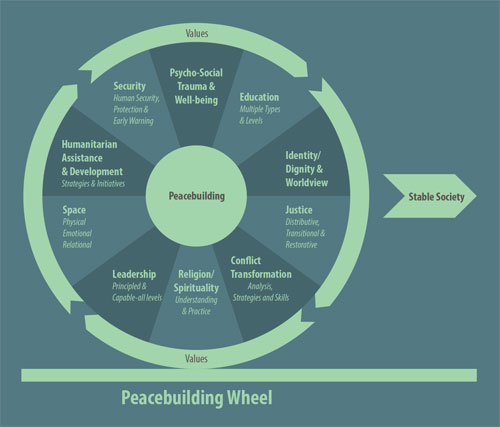A Genealogy of Ideas
by: Jayne Docherty and Mikhala Lantz-Simmons
Journal 1 – What is Old is New Again
In the first issue, titled “What is Old is New Again,” authors Jayne Docherty and Mikhala Lantz-Simmons trace some of the origins of the peacebuilding field and highlight an alternative story that preceded and runs parallel to the popular perception of peacebuilding. This publication also illustrates how diagrams that help us think (heuristic devices) emerge from adventures of reflection and collaboration. The concept of peacebuilding and the practices related to it continue to evolve as more individuals and groups take up the challenge of working towards peace with justice. This journal is an invitation to join the conversation. Journal 1 is also available for download.

Podcast
Catherine Barnes and Lisa Schirch first met as students at George Mason University’s Institute for Conflict Analysis and Resolution. Their peacebuilding careers have since intersected in higher education and in the field. Part of their work has involved providing leadership and support for the Global Partnership for the Prevention of Armed Conflict (GPPAC), which in 2005 brought approximately 1,500 people from across the globe together and united civil society actors and their governments in an unprecedented way. In this podcast, Lisa and Catherine discuss their entry into the academic field of peacebuilding and some of their views on the development of civil society-focused peace initiatives. We recorded this conversation in April 2016 at EMU as part of an e-journal series, A Genealogy of Ideas, written by Jayne Docherty and Mikhala Lantz-Simmons.
Journal 2: Conflict Analysis: Tools for Asking Better Questions
In this second issue of our series, we focus on tools for analyzing a conflict.
These tools or models are expressions of evolving ideas. It’s why we’ve called this series A Genealogy of Ideas. Every tool reflects the assumptions and values of the person or groups who developed it and the conditions under which it was created.
If we understand the assumptions and values embedded in conflict analysis models we can better explain, use and modify them to fit our current circumstances.
This journal offers a taste of the tools for thinking that can be found in manuals on conflict transformation and peacebuilding.
Download Journal 2: Conflict Analysis


